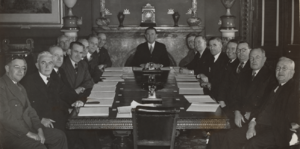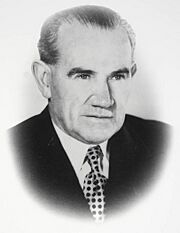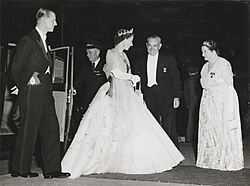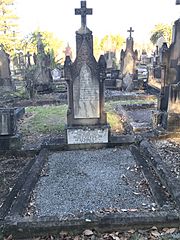Joseph Cahill facts for kids
Quick facts for kids
Joseph Cahill
|
|
|---|---|
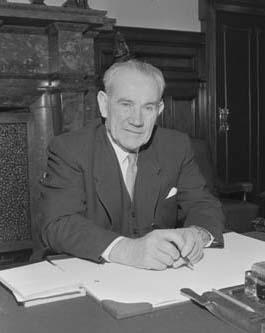 |
|
| 29th Premier of New South Wales Elections: 1953, 1956, 1959 |
|
| In office 2 April 1952 – 22 October 1959 |
|
| Monarch | Elizabeth II |
| Governor | Sir John Northcott Sir Eric Woodward |
| Deputy | Bob Heffron |
| Preceded by | James McGirr |
| Succeeded by | Bob Heffron |
| 3rd Deputy Premier of New South Wales | |
| In office 21 September 1949 – 2 April 1952 |
|
| Premier | James McGirr |
| Preceded by | Jack Baddeley |
| Succeeded by | Robert Heffron |
| Secretary for Public Works | |
| In office 16 May 1941 – 2 April 1952 |
|
| Premier | William McKell James McGirr |
| Preceded by | Lewis Martin |
| Succeeded by | Jack Renshaw |
| Minister for Local Government | |
| In office 8 June 1944 – 2 April 1952 |
|
| Premier | William McKell James McGirr |
| Preceded by | James McGirr |
| Succeeded by | Jack Renshaw |
| Member of the New South Wales Parliament for Cook's River |
|
| In office 10 May 1941 – 22 October 1959 |
|
| Preceded by | New district |
| Succeeded by | Tom Cahill |
| Personal details | |
| Born | 21 January 1891 Redfern, Colony of New South Wales |
| Died | 22 October 1959 (aged 68) Sydney, New South Wales, Australia |
| Resting place | Rookwood Cemetery |
| Political party | New South Wales Labor Party |
| Spouses | Esmey Mary Kelly (b.1891–m.1922–d.1971) |
| Children | Thomas James Cahill (1924–1983) John Joseph Cahill (1926–2006) Brian Francis Cahill (1930–2013) Mary (Gemma) Cahill Margaret Cahill |
John Joseph Cahill (born January 21, 1891 – died October 22, 1959), often called Joe Cahill, was a very important politician in New South Wales, Australia. He worked for the railways and was a strong supporter of workers' rights. Joe Cahill became the Premier of New South Wales for the Labor Party in 1952 and served until he passed away in 1959.
Born in Redfern, Sydney, Cahill started working for the New South Wales Government Railways at 16. He became a key figure in trade unions and the Labor Party. After many years as a politician, he became the Secretary for Public Works in 1941 and Minister for Local Government in 1944. During this time, he made big changes to local government.
In 1949, he became Deputy Premier. As Premier, he is best remembered for building important things after World War II. This included starting the famous Sydney Opera House and building the Cahill Expressway, which is now named after him.
Contents
Early Life and First Steps in Politics
Family and Early Work
Joe Cahill was born on January 21, 1891, in Redfern, a suburb of Sydney. His parents, Thomas and Ellen, were from Ireland. His father worked for the NSW railways. Joe went to school in Marrickville and Redfern. At 16, he started an apprenticeship as a fitter for the New South Wales Government Railways.
Joe became very active in workers' groups, like the Amalgamated Society of Engineers. He joined the Labor Party. He lost his railway job in 1917 because he took part in a big strike for better pay and conditions for railway workers.
First Election Attempts
In March 1917, Joe Cahill tried to become a politician for the first time. He ran for the Parliament of New South Wales in the area of Dulwich Hill. He had big ideas, like getting rid of the Legislative Council. He lost this election.
After a tough time finding work, he got a job selling insurance. In 1922, he was rehired by the New South Wales Government Railways. On November 11, 1922, he married Esmey Mary Kelly. They had three sons and two daughters. Their first son, Thomas James, was named after Joe's younger brother, who died in France during World War I.
In 1925, Joe Cahill was elected to the NSW Legislative Assembly for the area of St George. This was when the Labor Party, led by Jack Lang, came back into power. Joe Cahill was not a close friend of Lang. He stayed a regular member of parliament during Lang's time as leader.
In 1932, Joe lost his seat in parliament. But this was only for a short time. He stayed loyal to the Labor Party and was re-elected in 1935. He continued to speak up for railway workers in parliament. In 1939, he supported William McKell when McKell became the new leader of the Labor Party.
Becoming a Minister
In May 1941, the Labor Party won the state election, and William McKell became Premier. Joe Cahill was given an important job: Secretary of Public Works. This meant he was in charge of big building projects for the state.
His job was very important during World War II. He helped open the NSW Government Engineering and Shipbuilding Undertaking, also known as the State Dockyard, in Newcastle in 1942. This dockyard built ships and other important things for the war effort. Joe Cahill was very proud of this achievement. He said it would become one of the "great institutions" for Australia, both during and after the war.
Other projects he started included building defense sites and improving water and electricity systems. After the war, he planned many new public works, like new ports and roads. He also helped build a new mental hospital and improve the Cooks River.
In 1944, Joe Cahill also became the Minister for Local Government. He held this job for eight years. In this role, he made local councils more powerful. He helped set up the State Brickworks and the Electricity Commission of New South Wales. The Electricity Commission brought electricity to many country areas of New South Wales. He also helped create the Cumberland County Council, which made a big plan for how Sydney would grow.
In September 1949, Joe Cahill was chosen to be the Deputy Premier. This meant he was second in charge of the government.
Leading New South Wales
In April 1952, the Premier, James McGirr, resigned because of his health. Joe Cahill was the natural choice to take over. On April 3, 1952, he was elected Premier of New South Wales. He won the state elections in 1953, 1956, and 1959, showing that people trusted his leadership.
The Sydney Opera House
One of Joe Cahill's most famous achievements was starting the Sydney Opera House. In November 1954, he first suggested building an opera house in Sydney. In September 1955, he announced a worldwide competition to design it. The winner was a Danish architect named Jørn Utzon in January 1957.
Some people thought the opera house was too expensive. But Joe Cahill believed it should be for everyone. He said it would be a place where "the average working family will be able to afford to go." He wanted it to be a symbol of a fair and democratic country.
On February 5, 1959, Joe Cahill signed the first building contract for the Opera House. On March 2, 1959, the official building work began. Joe Cahill said the Sydney Opera House would be "a shrine" for great artists and a place to show off Australian culture.
Keeping the Party United
During the 1950s, the Labor Party faced big problems in other states. But Joe Cahill was a very skilled leader. He worked closely with the Catholic Archbishop of Sydney, Cardinal Norman Gilroy. This helped keep the Labor Party in New South Wales strong and united, avoiding the splits that happened elsewhere.
End of an Era
Joe Cahill was a heavy smoker and his health got worse in 1959. He passed away in October 1959 from a heart attack. His Deputy Premier, Bob Heffron, took over as Premier. Joe Cahill was the longest-serving Premier of New South Wales at that time.
His Legacy
Joe Cahill was survived by his wife, Esmey, and their five children. He was given a state funeral at St Mary's Cathedral, Sydney. Over 3,000 people attended his funeral, including the Governor and the Prime Minister. It is estimated that about 200,000 people lined the streets as his funeral procession went to Rookwood Cemetery.
His oldest son, Thomas James Cahill, was elected to his father's old seat in parliament. His second son, John Joseph Cahill, became a judge.
Joe Cahill received several awards during his life. He was given honorary degrees from the University of Sydney, the New South Wales University of Technology, and the University of New England.
Many places were named after him to honor his work. In 1958, the new highway across Circular Quay was named the "Cahill Expressway". In 1959, a lookout in Katoomba was named "Cahills Lookout". In 1961, a park in Wolli Creek was named "Cahill Park".
The J J Cahill Memorial High School in Mascot was also named after him. The school was officially opened by his wife, Esmey, in 1961. The school's motto, "Do what is right because it is right," reflects Joe Cahill's own values and how he lived his life.


